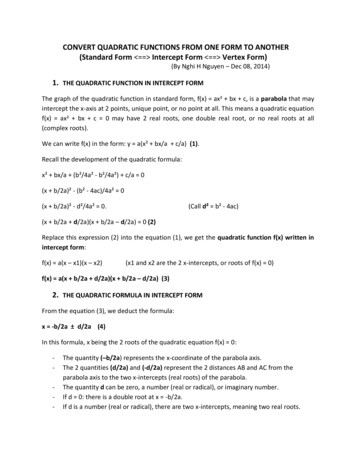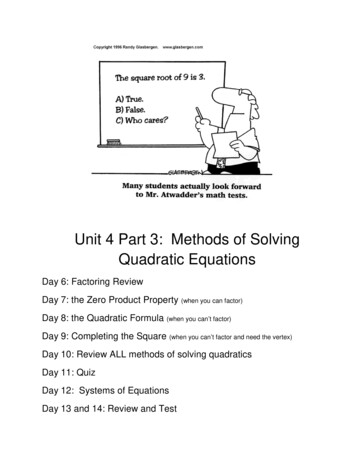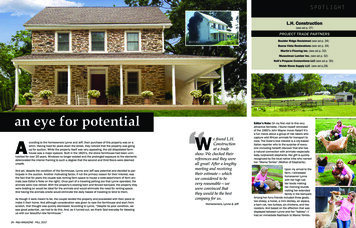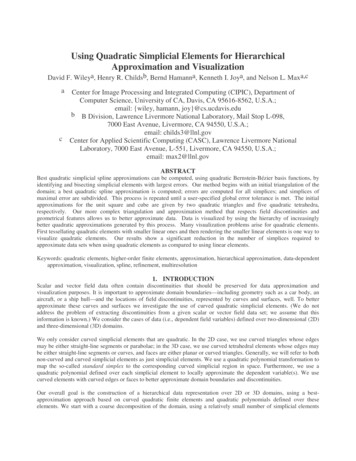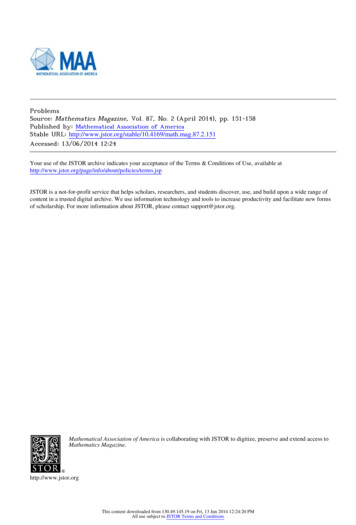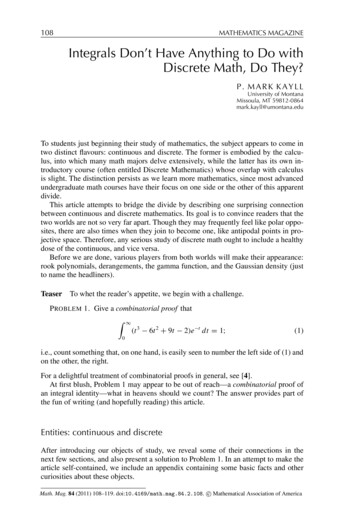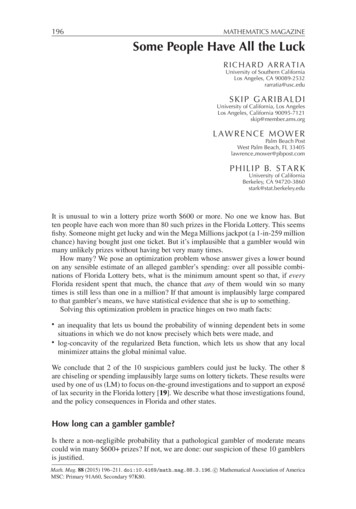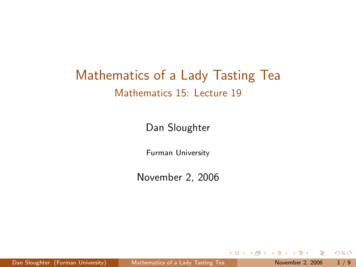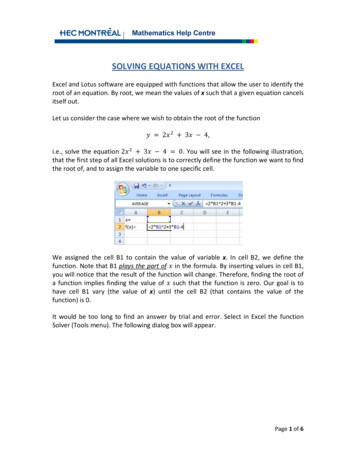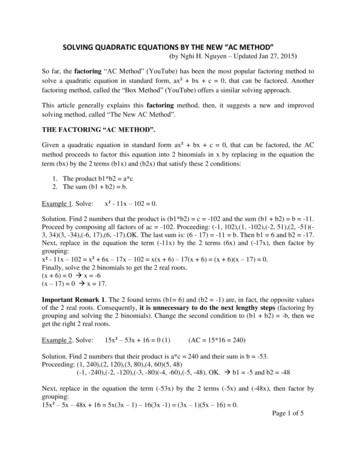
Transcription
SOLVING QUADRATIC EQUATIONS BY THE NEW “AC METHOD”(by Nghi H. Nguyen – Updated Jan 27, 2015)So far, the factoring “AC Method” (YouTube) has been the most popular factoring method tosolve a quadratic equation in standard form, ax² bx c 0, that can be factored. Anotherfactoring method, called the “Box Method” (YouTube) offers a similar solving approach.This article generally explains this factoring method, then, it suggests a new and improvedsolving method, called “The New AC Method”.THE FACTORING “AC METHOD”.Given a quadratic equation in standard form ax² bx c 0, that can be factored, the ACmethod proceeds to factor this equation into 2 binomials in x by replacing in the equation theterm (bx) by the 2 terms (b1x) and (b2x) that satisfy these 2 conditions:1. The product b1*b2 a*c2. The sum (b1 b2) b.Example 1. Solve:x² - 11x – 102 0.Solution. Find 2 numbers that the product is (b1*b2) c -102 and the sum (b1 b2) b -11.Proceed by composing all factors of ac -102. Proceeding: (-1, 102),(1, -102),(-2, 51),(2, -51)(3, 34)(3, -34),(-6, 17),(6, -17).OK. The last sum is: (6 - 17) -11 b. Then b1 6 and b2 -17.Next, replace in the equation the term (-11x) by the 2 terms (6x) and (-17x), then factor bygrouping:x² - 11x – 102 x² 6x – 17x – 102 x(x 6) – 17(x 6) (x 6)(x – 17) 0.Finally, solve the 2 binomials to get the 2 real roots.(x 6) 0 x -6(x – 17) 0 x 17.Important Remark 1. The 2 found terms (b1 6) and (b2 -1) are, in fact, the opposite valuesof the 2 real roots. Consequently, it is unnecessary to do the next lengthy steps (factoring bygrouping and solving the 2 binomials). Change the second condition to (b1 b2) -b, then weget the right 2 real roots.Example 2. Solve:15x² – 53x 16 0 (1)(AC 15*16 240)Solution. Find 2 numbers that their product is a*c 240 and their sum is b -53.Proceeding: (1, 240),(2, 120),(3, 80),(4, 60)(5, 48)(-1, -240),(-2, -120),(-3, -80)(-4, -60),(-5, -48). OK. b1 -5 and b2 -48Next, replace in the equation the term (-53x) by the 2 terms (-5x) and (-48x), then factor bygrouping:15x² – 5x – 48x 16 5x(3x – 1) – 16(3x -1) (3x – 1)(5x – 16) 0.Page 1 of 5
Next, solve the 2 binomials:(3x – 1) 0 x 1/3(5x – 16) 0 x 16/5Important Remark 2. The 2 numbers b1 -5 and b2 -48 are in fact the opposite values of the2 real roots of a simplified equation: x² - 53x 240 0 (2). Solve this simplified equation (2) toget (b1 5) and (b2 48), then divide them by (a 16), we can get the 2 real roots of theoriginal equation (1): x1 b1/15 5/15 1/3; and x2 b2/15 48/15 16/5.It is unnecessary to do the next lengthy steps: factor by grouping and solving the binomials.Remark 3. The existing factoring AC Method can be considerably improved if we apply theRule of Sign for real roots into its solving approach.RECALL THE RULE OF SIGN FOR REAL ROOTS.a. When a and c have different signs, both real roots have different signs.Example. The equation 5x² 8x - 13 0 has 2 real roots with opposite signs: (1) and (-13/5)Example. The equation 7x² – 8x – 15 0 has 2 real roots with opposite signs: (-1) and (15/7)b. When a and c have the same sign, both real roots have the same sign.-If a and b have opposite signs, both real roots are positive.Example: The equation 8x² - 11x 3 0 has 2 real roots both positive: 1 and 3/8.Example: The equation 13x² – 21x 8 0 has 2 real roots both positive: 1 and 8/13-If a and b have same sign, both real roots are negative.Example: The equation 8xv 11x 3 0 has 2 negative real roots: (-1) and (-3/8).Example: The equation 13x² 23x 10 0 has 2 negative real roots: (-1) and (-10/13).THE NEW “AC METHOD”.This method proceeds to find 2 numbers b1 and b2 that satisfy these 3 conditions:1. The product b1*b2 ac2. The sum (b1 b2) -b (instead of b)3. Application of the Rule of Signs into the solving process.CASE 1. When a 1. Solving quadratic equation type x² bx c 0When a 1, solving results in finding 2 numbers knowing their product (c) and their sum (-b).This method can immediately obtain the 2 real roots of the quadratic equation by composingPage 2 of 5
factor pairs of c. The factor pair, whose sum equals to (b), or (-b), gives the 2 real roots. There isno need for factoring by grouping or solving the 2 binomials.This method composes factor pairs of c following these 3 Tips.TIP 1. When a and c have opposite signs, roots have opposite signs. Compose factor pairs of cwith all first number being negative.Example 1. Solve:x² – 11x – 102 0.Solution. Since a and c have opposite signs, roots have opposite signs. Compose the factor pairsof (c -102) with all first numbers being negative.Proceeding: (-1, 102),(-2, 51),(-3, 34),(-6, 17). OK!.The sum of the last pair is: 17 – 6 11 -b. Then the 2 real roots are -6 and 17. There is no needfor factoring by grouping and solving the 2 binomials for x.TIP 2. When both real roots are positive (a and c same sign, a and b different signs), composefactor pairs of c with all positive numbers.Example 2. Solve:x² - 27x 126 0.Solution. Both roots are positive. Compose factor pairs of c 126 with all positive numbers.Proceeding: (1, 126)(2, 63)(3, 42)(6, 21). OK. This last sum is (6 21) 27 -b. Then, the 2real roots are: 6 and 21.TIP 3. When both real roots are negative (a and c same sign, a and b same sign), compose factorpairs of c with all negative numbers.Example 3. Solvex² 31x 108 0Solution. Both roots are negative. Compose factor pairs of c 108 with all negative numbers.Proceeding: (-1, -108),(-2, -54),(-3, -36),(-4, -27). OK This last sum (-4, -27) -31 -b. Thenthe 2 real roots are: -4 and -27. There is no need for factoring and solving binomials.CASE 2. When a 1 - Solving quadratic equations in standard form ax² bx c 0 (1)In this case, the “new AC Method” proceeds to transform the standard form into a simplifiedform x² bx C 0, with a 1, and with C a*c. The transformed equation has this form: x² bx a*c 0. (2)Solving method for this transformed equation (2) goes back to CASE 1: finding 2 numbers x1and x2 knowing their sum (-b) and their product (a*c).Page 3 of 5
Example 4. Solve:8x² – 22x – 13 0. (1)(AC -13*8 -104)Solution. Solve the transformed equation: x² - 22x – 104 0 (2). Roots have opposite signs.Compose factor pairs of (-104) with all first numbers being negative.Proceeding: (-1, 104),(-2, 52),(-4, 26). OK. This last sum is 22 -b. Then, the 2 real roots of theequation (2) are: -4 and 26. Next, divide these numbers by a 8 to get the 2 real roots of theoriginal equation (1).x1 -4/8 -1/2, and x2 26/8 13/4. No factoring by grouping.Example 5. Solve:12x² 5x – 72 0. (1)(AC 12*-72 -864)Solution. Solve the transformed equation: x² 5x – 864 0 (2). Roots have opposite signs.Compose factor pairs of -864 with all first numbers being negative. Since b 5 is too small ascompared to ac -864, start composing factors from the middle:Proceeding: ,(-16, 54),(-18, 48),(-24, 36),(-32, 27). OK. This sum is (-32 27) -5 -b.The 2 real roots of (2) are: -32 and 27. Then, the 2 real roots of the original equation (1) are: x1 -32/12 -8/3, and x2 27/12 9/4. No factoring by grouping.Example 6. Solve:24x² 60x 36 0.(AC 24*36 864)Solution. Solve transformed equation: x² 59x 864 0 (2). Both real roots are negative.Compose factor pairs of a*c 864 with all negative numbers, and start composing from themiddle of the chain. Proceeding: .(-9, -96),(-12, -72),(-16, -54),(-18, -48),(-24, -36), OK.This sum (-24 - 36) -60 -b. The 2 real roots of (2) are: -24 and -36. Then, the 2 real roots ofthe original equation are: x1 -24/24 -1, and x2 -36/24 -3/2Example 7. Solve:16x² – 55x 21 0.(AC 16*21 336)Solution. Solve transformed equation: x² - 55x 336 0 (2). Both roots are positive. Composefactors of ac with all numbers positive. Proceeding: (1, 336),(2, 168),(4, 82)(6, 56),(7, 48). OK.This sum is 7 48 55 -b. Then, the 2 real roots of (2) are: 7 and 48.Back to the original equation (1), the 2 real roots are: x1 7/16, and x2 48/16 3.More examples of solving by the New AC MethodExample 8. Solve6x² 17x -14 0 (1).(AC -14*8 -84)Solution. Solve the transformed equation: x² 17 x – 84 0 (2). Roots have different signs.Compose factor pairs of a*c -84 with all first numbers being negative. Proceeding: (-1, 84)(-2,42)(-3, 28)(-4, 21). This last sum is 21 – 4 17 b. Then, the 2 real roots are the opposite of -4and 21. The 2 real roots are 4 and -21. Back to equation (1). The 2 real roots are: x1 4/6 2/3;and x2 -21/6 -7/2.Page 4 of 5
Example 9. Solve:16x² - 62x 21 0 (1).(AC 16*21 336)Solution. Solve transformed equation x² - 62x 336 0 (2). Both real roots are positive.Compose factor pairs of a*c 336 with all positive numbers. Proceeding: (1, 336)(2, 168)(4, 82)(6, 56). The last sum is: 6 56 62 -b. Then, the 2 real roots of (2) are: 6 and 56. Back toequation (1), the 2 real roots are; x1 6/16 3/8; and x2 56/16 7/2. No factoring.Example 10. Solve:12x² 46x 20 0 (1).(AC 16*21 240)Solution. Solve transformed equation: x² 46x 240 (2). Both real roots are negative. Composefactor pairs of 240 with all negative numbers. Proceeding: (-1, -240)(-2, -120)(-3, -80)(-6, -40).The last sum is -46 -b. Then, the 2 real roots of (2) are: -6 and -40. Back to the originalequation (1), the 2 real roots are: x1 -6/12 -1/2; and x2 -40/12 -10/3.CONCLUSIONThe existing factoring “AC Method” can be considerably improved by applying the Rule ofSigns for real roots into its solving approach. This improved method helps avoid the unnecessarylengthy steps of factoring by grouping and solving binomials. That is why this improved methodmay be simply called: “The New AC Method”.Its strong points are: simple, fast, no guessing, systematic, no factoring by grouping, and nosolving binomials.References:- The new Transforming Method to solve quadratic equations (Google, Yahoo, Bing).- The Bluma Method (Google, Yahoo)- AC method for factoring. Regent Exam Prep Center at www.regentsprep.org- Factoring trinomials – Simplified AC Method at 2000clicks.com/mathhelp[This article was written by Nghi H. Nguyen, author of the new Transforming Method (Google,Yahoo, or Bing Search) for solving quadratic equations – Updated Jan 27, 2015].Page 5 of 5
SOLVING QUADRATIC EQUATIONS BY THE NEW “AC METHOD” (by Nghi H. Nguyen – Updated Jan 27, 2015) So far, the factoring “AC Method” (YouTube) has been the most popular factoring method to solve a quadratic equation in stand
